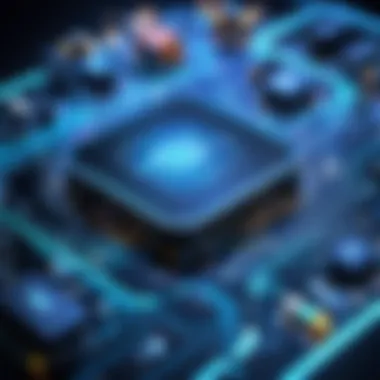Exploration of Internet of Things: Implications, Applications, and Challenges Unveiled


Tech Trend Analysis
The Internet of Things (Io T) stands at the cusp of transforming the tech landscape. Interconnecting devices to facilitate data exchange and automation, the IoT heralds a new era of connectivity 🌐. Reflecting on the current trend, consumers are increasingly leveraging IoT applications to enhance efficiency and comfort in their daily lives. The implications of this technology permeate various sectors, presenting innovative solutions while raising concerns about data security and privacy. Looking ahead, the IoT holds the promise of further advancements in smart technology integration that can revolutionize industries and consumer experiences.
Product Reviews
Embarking on an exploration of Io
How-To Guides
Introducing beginners to the concept of Io T lays the foundation for navigating this complex technological landscape with ease. Step-by-step instructions provide a practical framework for setting up and integrating IoT devices into daily routines. Offering valuable tips and tricks ensures a seamless user experience, enhancing the functionality and usability of IoT technology. When encountering technical challenges, effective troubleshooting strategies empower users to resolve issues efficiently, fostering confidence and proficiency in utilizing IoT devices effectively.
Industry Updates
Stay abreast of recent developments in the tech industry with a keen focus on Io T advancements. Analyzing market trends highlights the growing influence of IoT on businesses and consumers, shaping new opportunities and challenges. As industries adapt to the transformative power of IoT technology, the impact reverberates across sectors, driving innovation and reshaping operational paradigms. By monitoring industry updates, professionals can anticipate changes, leverage emerging trends, and capitalize on the myriad possibilities offered by the interconnected world of IoT.
Introduction to IoT
In the modern technological landscape, the Introduction to Io T plays a pivotal role as a foundational concept shaping the interconnected world. IoT, or the Internet of Things, stands as a revolutionary paradigm where objects, devices, and systems are seamlessly connected to exchange data and automate processes. Understanding the intricacies of IoT is paramount in grasping the essence of this transformative technology. From optimizing efficiency in home environments to streamlining industrial operations, IoT's implications are vast and profound, making it a subject of great significance in today's digital era.
Definition of Internet of Things


The Definition of Internet of Things encapsulates the essence of a network where everyday devices communicate with each other through the internet. Io T extends connectivity beyond standard devices like computers and smartphones to a wide array of objects, enabling them to collect and share data autonomously. This interconnected ecosystem facilitates a seamless flow of information, revolutionizing how devices interact and operate in various environments. By defining the scope and mechanics of IoT, one can appreciate the complexity and innovation that underpin this groundbreaking concept.
Evolution of IoT
The Evolution of Io T traces its origins from the early ideas of interconnected devices to the sophisticated network of today. Initially conceptualized as a way to enhance communication and efficiency, IoT has evolved into a fundamental aspect of the digital infrastructure. Advancements in technology, such as miniaturization, wireless connectivity, and cloud computing, have propelled the evolution of IoT, enabling its integration into diverse domains. Understanding this progression sheds light on the iterative development and growth of IoT as a disruptive force in the tech industry.
Key Components of IoT
The Key Components of Io T include sensors, connectivity, data processing, and actuators, all working in harmony to enable seamless communication and automation. Sensors serve as the sensory organs of IoT, collecting data from the environment. Connectivity mechanisms, such as Wi-Fi and Bluetooth, facilitate data transfer between devices. Data processing algorithms analyze information, extracting valuable insights. Actuators translate digital commands into physical actions, closing the loop in IoT operations. Delving into these components unveils the intricate framework that powers the interconnected ecosystem of IoT, shaping its functionalities and applications.
Functionalities and Applications
In the digital landscape dominated by the Internet of Things (Io T), the category of Functionalities and Applications stands at the forefront of innovation and utility. This section elucidates the pivotal role of Functionalities and Applications within the broader spectrum of IoT technology. Understanding the core functions and practical applications of IoT is imperative for grasping the magnitude of its impact on various facets of modern life. By dissecting the intricate layers of IoT's Functionalities and Applications, we unravel the underlying mechanisms that drive this interconnected ecosystem. From data collection to real-time analysis, and from automation to control systems, Functionalities and Applications encapsulate the essence of IoT's transformative potential.
Data Collection and Analysis
Data Collection and Analysis represent the backbone of Io T operations, facilitating the seamless flow of information between connected devices. The process of collecting data from diverse sources and meticulously analyzing it plays a crucial role in deriving valuable insights and optimizing performance. In the realm of IoT, data serves as the lifeblood that fuels decision-making and enhances operational efficiency. By exploring the nuances of data collection methodologies and the significance of robust analytics frameworks, we gain a comprehensive understanding of how IoT thrives on the continuous influx and interpretation of data streams.
Automation and Control Systems
Automation and Control Systems constitute the nerve center of Io T deployments, orchestrating the coordination of devices and processes with precision and efficacy. Through the integration of automated workflows and intelligent control mechanisms, IoT empowers businesses and individuals to automate tasks, streamline operations, and enhance productivity. Delving into the realm of Automation and Control Systems unveils a realm where efficiency meets innovation, paving the way for a future where manual interventions are minimized, and processes are optimized for maximum output.
IoT in Healthcare


Within the sphere of healthcare, Io T solutions have ushered in a new era of patient care, monitoring, and treatment. The integration of IoT technologies in healthcare systems enables remote patient monitoring, predictive analytics, and personalized treatment plans. By examining the impact of IoT on healthcare delivery, we navigate through a landscape where efficiency, accuracy, and patient outcomes converge to redefine the standards of medical practice. IoT in Healthcare not only enhances the quality of care but also revolutionizes the patient experience by leveraging connectivity and data-driven insights.
Smart Homes and Cities
Smart Homes and Cities represent the epitome of Io T applications, epitomizing the fusion of technology with urban living. From smart appliances that optimize energy consumption to city-wide infrastructure that enhances sustainability and livability, IoT revolutionizes the way we interact with our living spaces. Exploring the intersection of IoT with domestic and urban environments unveils a canvas where innovation, efficiency, and connectivity converge to create a harmonious ecosystem. Smart Homes and Cities epitomize the modern vision of interconnected living, where convenience, security, and sustainability coexist seamlessly.
Benefits and Challenges
In the vast landscape of the Internet of Things (Io T), exploring the realm of benefits and challenges becomes paramount. Understanding the intricate balance between the advantages and obstacles inherent in IoT is crucial for a comprehensive grasp of this evolutionary technology. The benefits of IoT are multifold, ranging from enhanced efficiency in processes to improved data insights and decision-making capabilities. Businesses leveraging IoT applications can experience increased productivity, cost reductions, and better customer experiences. Conversely, the challenges posed by IoT revolve around data security, privacy concerns, interoperability issues, and the complexity of managing interconnected devices. Addressing these challenges is pivotal for the sustainable and secure integration of IoT solutions across various industries.
Advantages of IoT
Delving deeper into the advantages of the Internet of Things unveils a tapestry of opportunities awaiting exploration. Io T empowers organizations with real-time insights into operations, enabling predictive maintenance, remote monitoring, and proactive interventions. Enhanced connectivity facilitated by IoT fosters seamless communication among devices, leading to streamlined workflows and improved resource utilization. The scalability of IoT solutions allows businesses to adapt to evolving demands swiftly, ensuring a competitive edge in dynamic markets. Harnessing IoT advantages translates into operational excellence, innovation acceleration, and unparalleled customer satisfaction, redefining the modern business landscape.
Security Concerns
Navigating the intricate realm of Io T security concerns demands a meticulous approach to fortifying network infrastructures. The proliferation of interconnected devices increases the vulnerability to cyber threats, necessitating robust security protocols and vigilant monitoring practices. Potential security breaches in IoT ecosystems could compromise sensitive data, disrupt operations, and tarnish organizational reputations. Implementing encryption, authentication mechanisms, and regular security audits are imperative safeguards against malicious intrusions. Mitigating security concerns ensures the reliability and integrity of IoT systems, fostering trust among stakeholders and safeguarding critical assets from cyber risks.
Privacy Issues
Delving into the depths of Io T privacy issues unravels a tapestry of complexities surrounding data protection and user consent. The ubiquitous nature of IoT devices collecting vast amounts of personal information raises concerns about individual privacy rights and data misuse. Striking a balance between data collection for optimizing services and respecting user privacy preferences is a delicate endeavor. Regulatory compliance frameworks such as GDPR play a significant role in governing data handling practices and ensuring transparency in data processing operations. Safeguarding consumer privacy through anonymization techniques, clear privacy policies, and user control mechanisms is essential for fostering trust in IoT ecosystems and upholding ethical standards in data utilization.
Future Trends in IoT


In the ever-evolving realm of the Internet of Things (Io T), future trends play a pivotal role in shaping the landscape of connected devices and systems. Anticipating the trajectory of IoT developments is essential for stakeholders in tech and business spheres. The significance of understanding future trends lies in anticipating market demands, technological advancements, and consumer preferences, thereby staying ahead in a competitive environment. Exploring future trends in IoT nurtures innovation, enabling organizations to adapt proactively to emerging technologies and trends.
Artificial Intelligence Integration
Embracing Artificial Intelligence (AI) is paramount in propelling Io T to new horizons. The convergence of AI and IoT amplifies the capabilities of connected devices by enabling intelligent decision-making and autonomous actions. AI integration empowers IoT systems to analyze vast volumes of data in real-time, extract valuable insights, and respond intelligently to dynamic conditions. Leveraging AI algorithms enhances the efficiency, accuracy, and predictive capabilities of IoT applications across various domains, revolutionizing industries and consumer experiences.
Edge Computing
Within the Io T paradigm, Edge Computing emerges as a critical enabler of real-time processing and decision-making at the edge of networks. By decentralizing data processing and storage to the periphery of networks, Edge Computing minimizes latency, enhances data security, and optimizes bandwidth usage. This distributed computing framework empowers IoT devices to perform computation closer to data sources, accelerating response times and enabling localized decision-making. Edge Computing holds immense potential in enhancing IoT scalability, reliability, and performance across diverse use cases.
5G Connectivity
The advent of 5G Connectivity heralds a new era of connectivity standards that promise unparalleled speed, bandwidth, and reliability for Io T deployments. 5G technology revolutionizes the IoT ecosystem by enabling high-speed data transmission, ultra-low latency, and massive device connectivity. The superior network capabilities of 5G facilitate seamless communication and interaction among IoT devices, unlocking new possibilities for immersive experiences, mission-critical applications, and smart solutions. Embracing 5G connectivity propels IoT infrastructure towards enhanced efficiency, connectivity, and transformative potential, redefining the digital landscape.
Impact of IoT on Industries
The Impact of Io T on Industries is a pivotal focus of this comprehensive article. Understanding how IoT influences various sectors is crucial in grasping the technological landscape's evolution. The interconnectivity facilitated by IoT revolutionizes traditional industries, streamlining processes, enhancing efficiencies, and fostering innovation.
Manufacturing Sector
In the Manufacturing Sector, Io T plays an integral role in optimizing production processes and revolutionizing manufacturing operations. By integrating sensors and smart devices, factories attain heightened levels of automation, predictive maintenance, and real-time monitoring. This leads to enhanced productivity, cost savings, and improved overall efficiency. IoT implementation enables seamless communication between machinery, inventory tracking, and quality control, paving the way for Industry 4.0 transformation.
Retail and Supply Chain Management
Io T's Impact on Retail and Supply Chain Management is transformative. Retailers leverage IoT technologies for inventory tracking, demand forecasting, and personalized customer experiences. With sensors monitoring stock levels and consumer preferences in real-time, businesses can streamline logistics, optimize supply chains, and minimize stockouts. IoT-driven analytics provide valuable insights into consumer behavior, preferences, and buying patterns, empowering retailers to make data-driven decisions and enhance customer satisfaction.
Transportation and Logistics
In the realm of Transportation and Logistics, Io T revolutionizes fleet management, route optimization, and supply chain visibility. By equipping vehicles with IoT sensors, companies improve delivery accuracy, reduce fuel consumption, and enhance driver safety. Real-time tracking and monitoring allow for efficient route planning, vehicle maintenance scheduling, and cargo condition monitoring. IoT integration in logistics enables seamless coordination, increased operational efficiencies, and enhanced customer service delivery.



